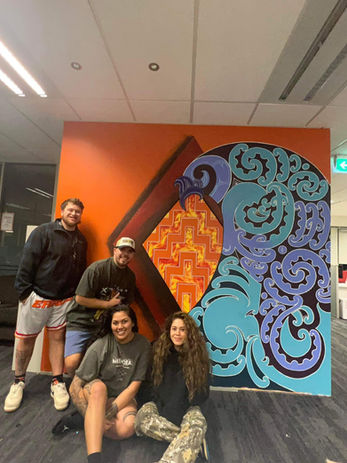World vision mural 2022
Poutama – orange diamond in the centre
The poutama is understood as the staircase in which Tāne-nui-a-rangi ascended ngā rangi tūhāhā (the heavenly realms) to retrieve ngā kete o te wānanga (the three sacred baskets of knowledge) from Io-Matua-Kore (God the Creator) and brought them back to the people of this earthly realm.
Symbolically, while Tāne was ascending throughout the heavenly realms, he was learning, understanding, and growing. He had to rest on the horizontal steps of the poutama to process everything he had learned, before continuing to climb the vertical, achieving a deeper understanding, broadening his capacity and fuller knowledge.
Woven together with our values, we acknowledge our connection with God the Creator who gifted us with faith, hope, and love – 1 Cor 13:13. While we have our Christian heritage, we also acknowledge our responsibility to tāngata whenua through Te Tiriti o Waitangi and our commitment to reconciliation, which is reflected in this tohu (mural).
We continue to “fight the good fight” for many vulnerable children and communities across the world. We’re consistently learning, growing and understanding the mission set before us. As we rest and process our collective efforts, we enter into a fuller knowledge of what we have been called to. The colour orange represents hope and is synonymous with who we are as WVNZ – a symbol of optimism, progress and a better future.
Tāniko – left of the poutama in red
The tāniko is a traditional weaving technique and pattern used by Māori. It took time, patience, and perseverance to prepare muka (the fibre of the harakeke) in order to weave important items for the community, such as korowai (fine cloaks), kete (baskets/bags) or tukutuku (stories in panels).
In this instance, the tāniko border signifies the people, stories, connections, whakapapa, and relationships that have been woven into our journey. Regardless of who has come in the past, present, or future, all are interwoven into the WVNZ story.
Manaia – purple above the poutama
The manaia is a kaitiaki (guardian) against evil and can act as a messenger between the spiritual and earthly realms.
It is also a reminder of the connection back to the Pacific Islands and the ancestral lands of Hawaiki. The manaia can be used in whakairo (carvings), wharenui (meeting houses) and moko (markings on the body).
In this piece, the manaia is representing the guardianship that has been bestowed upon the WVNZ family. Being towards the centre of the entire piece, it is a reminder of the core mahi (work) and responsibility that we have towards ‘ngā tāngata ō tēnei whenua me te ao katoa’ – the people of this land and of the world.
Pītau-a-manaia – to the right of the poutama
The pītau-a-manaia is a traditional kōwhaiwhai pattern and has a significant connection to Te Tai Rāwhiti (East Coast of the North Island). Te Tai Rāwhiti is the first place in the world to see the light of day. It is an important reminder to stay connected to the one who gives us love and light, Io-Matua-Kore (God the Creator).
WVNZ is the first to see God’s love, light, and justice for the hurting, lost, orphaned, sick, hungry, marginalised, poor, exploited and disadvantaged. The pītau-a-manaia makes up the complete body of the manaia as an ongoing reminder for the WVNZ whānau.
Another story connected to the pītau-a-manaia is that when the missionaries came to Aotearoa, they requested a church to be built by Māori in Te Tai Rāwhiti. They told Māori that they weren’t allowed to put any carvings or anything that idolised other gods.
For Māori, this wasn’t always the case as carvings specifically represented their tūpuna (ancestors). Those who had paved the way and created a foundation for the future generations to thrive. This is a reminder of where we come from, of whom we come from and what this means for the future generations of our land and of the lands we serve.















